The amputation of a limb is a life changing experience, and the requirements of each client are different and will change throughout their life. Whether you or a loved one has undergone a lower limb (leg) amputation or an upper limb (arm) amputation and are new amputees, we are here to support you and help you reach your goals.
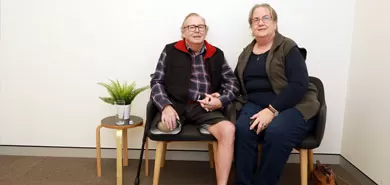
APC Prosthetics has a strong support system to assist clients in challenging situations and you can be sure that you or your loved one is in good hands with APC. Our philosophy is to work with new amputees to comprehensively assess their needs, establish their requirements and then deliver the most appropriate solutions.
All of our clients’ needs are unique, so our experienced prosthetists work closely with multidisciplinary health professionals to establish a customised treatment solution. The team includes Medical Specialists, Physiotherapists, Occupational Therapists, and other health professionals. You can read more information about allied health support services here.

If you have had a transtibial amputation (below knee) you will typically have been fit with some form of compressive & protective device, known as a removable rigid dressing (RRD) immediately after surgery. This hard, plaster cast acts as a crash helmet for your residual limb (or stump), helps with healing and controlling swelling. Depending on the hospital you are in, you may meet your prosthetist at this stage, but typically our first meeting with you comes in the lead up to making your first limb. In the weeks leading to casting, if you are either a below knee amputee or above knee amputee, we will fit you with a stump shrinker (a compressive stocking) to help you get some of the fluid and swelling dissipated. This aids in forming an appropriate shape of your residual limb ready for wearing a prosthetic socket.
The first phase of the prosthetic rehabilitation for new amputees is the provision of an interim prosthesis. This generally occurs approximately 6 weeks after leg amputation when the suture wounds have sufficiently healed. The aims of the interim prosthesis are to establish early mobility and commence gait re-education as early as possible. But how does it get paid for? Don’t worry, in Australia you don’t have to pay for your prosthetic management out of pocket.
FUNDING: All new amputees in NSW regardless of age, except for those covered by insurance claims, have their first prosthesis for rehabilitation funded through Enable (the state-based funder for interim prosthetic limbs and those over 65). After a comprehensive assessment with your prosthetist and the rehabilitation team, the rehabilitation specialist issues a prescription to ENABLE for the interim prosthesis. If your funding is through Insurance, then your prosthetist will send the funding request through to your case manager.
Once we have approval, the prosthetist will then take a plaster cast of the residual limb, which is called a plaster negative. The plaster negative is then used to make a replica of the residual limb, which is modified to achieve a comfortable socket. The socket is then moulded over the plaster model. You can read more about how the prosthesis is made here.
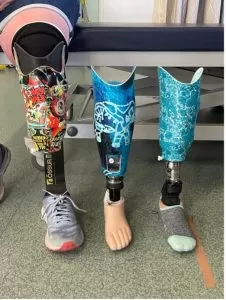
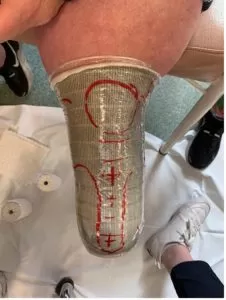
Various liner materials are used to act as a cushion between the socket and the residual limb, absorbing and dissipating shock, shear and torque forces that occur during walking and standing on the prosthesis.
Next, the prosthetic components such as the prosthetic foot or prosthetic knee are connected to the socket and the client then returns for their first prosthetic fitting. During this process one of our highly skilled prosthetists assesses the socket-fit and analyses gait to determine optimal alignment. The correct alignment of the prosthesis is essential to ensure maximum comfort and function.
You can expect regular modification to this first prosthesis, as the residual limb undergoes significant changes in shape and volume during the first months. It’s important to continue to work with your physio team for ongoing gait training, muscle strengthening and stretching for optimal outcomes. After approximately 3 to 4 months or when the limb has stabilised, the prosthetic interim socket will be replaced with the first definitive socket .

FUNDING : For your first definitive prosthesis, the prescription process is repeated (there are some different steps dependent on your funder). If you are deemed to have completed rehabilitation, are under 65, and not covered by insurance, you will need to apply to the NDIS to continue your prosthetic funding. This can be a lengthy process, requiring a lot of paperwork. Check out our resources on the NDIS and speak to your prosthetist as they will need to complete some of the application as your treatment provider. Your prosthetist will perform an Assistive Technology (AT) Assessment and send the request to fund your prosthetic prescription to the NDIS.
When funding is approved, the prosthetist will take a new cast of your residual limb and the manufacturing and optimising process begins again. This time there will first be a diagnostic or check socket. This prosthesis is trialled for several days-weeks. It’s important you trial the check socket in as many real-life scenarios as possible in order to give your prosthetist quality feedback on the suitability of the fit and function. After the successful completion of the trial period, the prosthesis is cosmetically finished, to deliver a pleasing aesthetic result. The materials used to manufacture the definitive socket include fibreglass, carbon fibre or specially designed plastics. Utilising the latest manufacturing technologies and high-tech materials ensures a durable and extremely light socket .
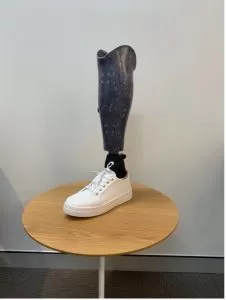
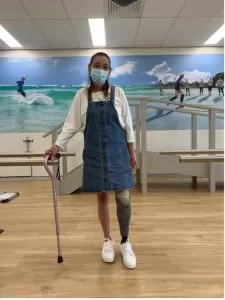
As the shape and volume of the residual limb will change over time, it is very important that the client sees their prosthetist on a regular basis (every 3 to 6 months), to ensure the socket is still fitting properly, and for the maintenance of the componentry. Sometimes it is necessary for the prosthetist to make adjustments to the prosthesis to compensate for any changes. However, if the changes are too significant, a new socket (socket replacement) might be required.
You will probably require more frequent socket replacements in the earlier years of your life as a prosthetic user and these will reduce in frequency over time. The other main reason for requiring a socket replacement, or replacement of prosthetic componentry is wear and tear. Over the years, the components may degrade or rust or get scratched up from you returning to your everyday life and meeting your goals!
If you are about to undergo amputation or have recently, and have any questions, feel free to reach out to us! We have all the information needed for new amputees.
